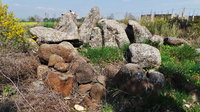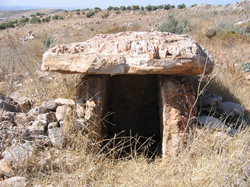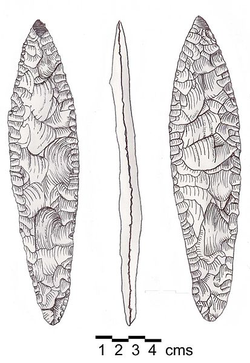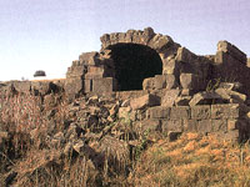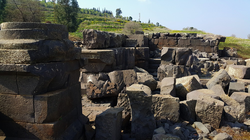Menjez
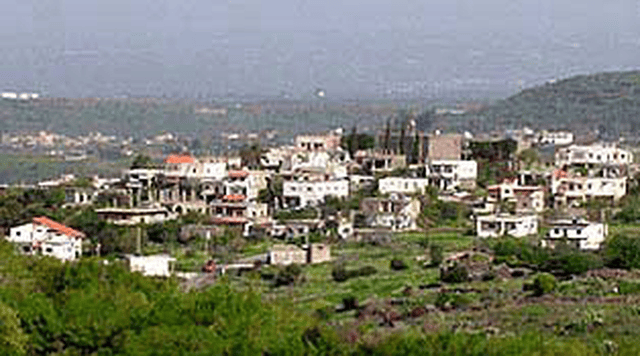
Menjez

Deir Saydet el Kalaa in Menjez, Akkar North of Lebanon - YouTube
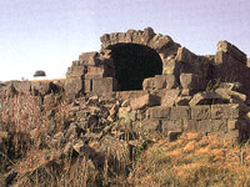
Beit Jaalouk (or "Maqam ar-Rabb") Temple
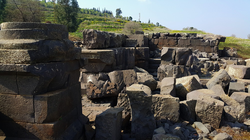
Menjez Temple (courtesy Lebanon Untravelled)
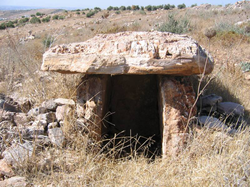
A Megalithic monument in Menjez (courtesy OLJ)

Megalithic Tomb at Menjez, Akkar (courtesy Lebanon Untravelled)
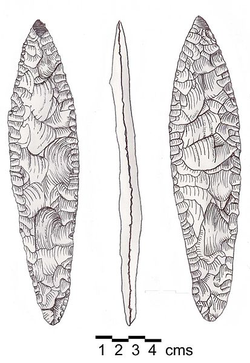
Canaanean Blade - Drawing by Paul Bedson copied from Lorraine Copeland's Inventory of Stone Age Sites in Lebanon, Mélanges de l'Université Saint-Joseph, Volume 41, Université Saint-Joseph (Beirut, Lebanon) 1965.
Menjez or Munjez (Arabic: (منجز is a village in the Akkar Governorate, Lebanon which features an archaeological complex of monuments that have been described as Lebanon's biggest megalithic necropolis.
[3] [5] It is 127 kilometres from Beirut, sits at an altitude of 350 metres and covers and area of 592 hectares.
[0]The village is home to around 300 families with 1600 inhabitants and 700 permanent residents.
The village is located on a hill bearing the name of a French Crusader family "El Guise", who built the monastery of "Our Lady of the Fortress" (Deir Saydet El Kalaa ). Sheikh Ibrahim El Khoury funded the reconstruction of the monastery into a church and helped the village's relations with it's neighbors, while avoiding villagers paying taxes to the Ottoman Empire.
To honor him, Jesuit fathers commemorated his memory with a slate above the door of the Church of Our Lady of the Fortress, which remains a prominent feature of the village.
[13] Since crusader times, the village has been called "Mont Guise" and as there was no phonetic synonym in the Arabic language, the name has been said to have drifted towards "Menjez".
[2]It has been alternatively suggested that the word Menjez comes from the Syraic words "Ngaz" or "Agnez" which means to "garner or hide a treasure". [9]
Archaeology
The village is home to Beit Jaalouk (or "Maqam ar-Rabb"), the remains of a Roman temple dedicated to the Goddess of vengeance Nemesis that was erected in the first century AD later converted to a Byzantine Church.
[4] In the valley below Beit Jaalouk are the remains of Roman Canaliz ations of Zenobia with retaining walls 5 metres high.
Over one hundred oval, rectangular, polygonal or cir cular Megali thic tombs have been recorded in the area, similar to those at nearby Tlayleh, first discovered by Mouterde in 1940, the full extent of which was documented by Jesuit Father Maurice Tallon in the 1950-60s who classified the sites "Menjez I" and "Menjez II".
[10] Eighty-seven have been recorded in m ore recent studies .
[7]Locals claim to have found up to one hundred and eighty.
The monuments are suggested to date to the Chalcolithic or Early Bronze Age however Lorraine Copeland admitted that "the plateau may have been occupied before" .
[10] The monuments are made with flat, basalt boulders inserted vertically in the ground, o ften with pointed tops.
The location has been suggested to be Lebanon's largest megalithic necropolis.
Some of the more complex monuments exhibited the feature of a kerb around them, with a couple of the larger ones showing two chambers.
[5]Over the top of the large stones, earth and rocks were laid to form a tumulus.
Menjez I
Menjez I was North West of the village and described as groups of monuments that were found in various areas :-
A ridge West of the Menjez ridge, on the left bank of the southern arm, between the road and the river (100 metres North of cote 346).
500 metres South West of the village near a road bridge where the road turns North towards the village.
Half way between Freidis and el Kousseir, right of the road, on a hill overlooking Menjez.
A plateau 300 metres South East of the village.
Maurice Tallon excavated 45 of the structures in 1961 (published 1965) and some other tombs and houses in 1964.
Several house foundations and floors were found, all made from the locally occurring, durable and flat basalt.
[10] Broken pottery and flint tools were found in the monuments including well made fan-scrapers, a ground stone axe and several Cananean blades.
Some of these blades found were very long with lustred, serrated edges.
Menjez II
Menjez II also known as "Aarid" is on sloping ground 100 metres West of Menjez by the edge of the plateau, with some other megalithic tombs noted on the steeper slopes above the Nahr Menjez.
[10] Flints from the Chalcolithic or Early Bronze Age were collected here in 1964 by Tallon that included some rare scrapers and 3 long, denticulated Cananean blades.
The material is stored in the Saint Joseph University.
Tara Steimer-Herbet and Marie Besse, head of the laboratory of prehistoric archeology and anthropology at the University of Geneva are furthering the work of Maurice Tallon at the sites referred to nowadays as Menjez.
Working together with former resident of the French Institute of the Near East (IFPO) of Damascus and Museum of Lebanese Prehistory curator, Maya Haïdar Boustani in collaboration with researchers with expertise in museography and tracing (University of Rennes and MegaNeo association) will do a thorough study of the architecture through preliminary scientific observations and 3D surveys.
Similarly, "consolidations will be made to restore the history of this site of heritage interest.
The initiative will be accompanied by a heritage house space and an archaeological route ". [7]
History **** For a long time the Maronites lived in the region.
The profession of faith issued at Qannoubin in March 1579, during the first mission of Father Eliano, bears the signature of several of their priests.
Before the Maronites, the land belonged before the "Turkmen", who lived in "Beyt Jumblat" and "Koura El Maabour".
**** It is said that the first family that settled in Menjez was "El Goumaa".
This family left her native village "Hadath El Joubé", bringing with her a stone from their old church of "Saint Daniel" which became the founding stone of the current church of the village dedicated to Saint Daniel.
Menjez fields were among the most productive in the whole region.
During the spring its fields were covered with a carpet of greenery decorated with thousands of flowers of all kinds of herbs which incited the shepherds of the neighborhood to graze their cattle in the fields.
N owadays these fields have been gradually invaded by construction and housing.
[3]
During the First World War (1914-1918) many of the men of the village were killed or fled.
A plague of grasshoppers caused a fatal famine and the departure of the Jesuit fathers in 1924 which provoked a deep sadness among the villagers.
I n 1976, many of the villagers had to leave Menjez during the Lebanese Civil War.

